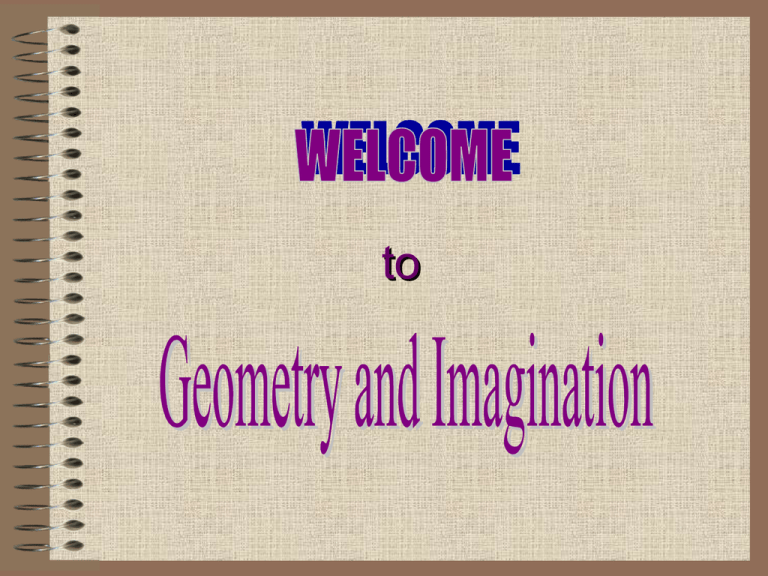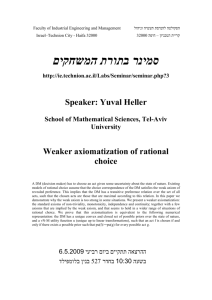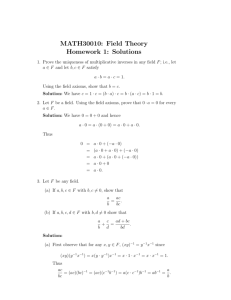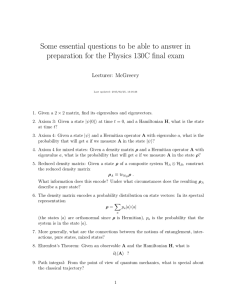to
advertisement

to Contact Emina • Email: eminaa@umich.edu • Office: East Hall 1825 • Phone: 734 647 5518 About me • Born in Bosnia: Real home Utah Family Your turn Please fill out the questionnaire Back to business Class website http://www.math.lsa.umich.edu/~eminaa/teaching/127w06/127.html Textbook • Shape of Space by Jeff Weeks Help Office hours: • Monday 10:15-11:30 • Wednesday 2:30-3:45 • Or email! Grading scheme • • • • 30% Homeworks 30% Quizzes 20% Midterm 20% Final Homeworks • • • • • • No late homeworks No extensions Write in complete sentences Listed on the website READ EACH SECTION IN ADVANCE First one due on 1/18. Exams • Midterm – oral and written presentation – February 22 – in class • Final – written presentation – April 21 by 12:00pm in EH1825 Geometry Topology Earth measure Place study Measurements Shapes Quick ride through history • Ancient geometry – Empirical results obtained through experimentation, observation, analogies, guessing – Often correct, but sometimes not Progress • Greek geometry – Insisted on deductive reasoning – Logical geometry – Euclid’s Elements Axiomatic method Procedure by which we demonstrate or prove that results are indeed correct. No experiments are needed to show the veracity of our claims! Proof Sequence of statements each of which logically follows form the ones before it and leads from a statement that is known to be true to the statements that is to be proved What is needed 1. Rules for when one statement follows from another 2. All readers must have a clear understanding of all terms and statements used Statements • A statement can be either true or false, but not both. • Statements can be combined: Statement P and Q P or Q If P then Q Not P Notation PQ P Q PQ P T when both P&Q are T F only when both P &Q are F F only if P is F and Q is T T if P is F, F is P is T Truth Table P Q T T T T T F T F F T T F F T F T F T F F F F T T P Q P Q P Q P 1. When does a statement follow from another logically? If we substituted in a tautology. Tautology is a statement that is true under all possible circumstances. Tautologies • PP • P P • (P Q) Q • (P (P Q)) Q Modus Ponens • ((P Q) Q) Q • ((P Q) (Q R)) (P R) 2. Definition of terms Define each unknown term in your discussion Define each unknown term in the new definition Define each unknown term in the new definition Define each unknown term in the new definition STOP!!!!! • Some terms will remain undefined: – Primitive terms • Primitive terms and definitions are combined into statements, theorems, which need to be proved using other theorems. • Some statements must remain unproved: – Axioms or postulates Example • Undefined terms: Bu, Ba, and relation on • Axiom 1: There are exactly three Bu’s. • Axiom2: Two distinct Bu’s are on exactly one Ba. • Axiom 3: Not all Bu’s are on the same Ba. • Axiom 4: Any two distinct Ba’s contain at least one Bu that is on both of them. Exercise • Theorem: Two distinct Ba’s contain exactly one Bu. – Axiom 1: There are exactly three Bu’s. – Axiom2: Two distinct Bu’s are on exactly one Ba. – Axiom 3: Not all Bu’s are on the same Ba. – Axiom 4: Any two distinct Ba’s contain at least one Bu that is on both of them Exercise • Theorem: Two distinct Ba’s contain exactly one Bu. Proof: Since Axiom 4 states that any two Ba’s have at least one Bu that’s on both, we only need to show that those two Ba’s can not have more than one Bu. Suppose that two Ba’s share two Bu’s. These two distinct Bu’s are on two different Ba’s which contradicts Axiom 2. Interpretation • Give each undefined term a particular meaning—interpretation • If all axioms are “correct” statements, the interpretation is called a model Model • Bu • Ba • On • Axiom • Person • Committee • Belongs to 1: There are exactly three people • Axiom 2: Two distinct people belong to exactly one committee. • Axiom 3: Not all people are on the same committee • Axiom 4: Any two distinct committees contain one person that belongs to both of them. NonModel • Bu • Ba • On • Axiom • Book • Shelf • on 1: There are exactly three books • Axiom 2: Two distinct books are on exactly one shelf. • Axiom 3: Not all books are on the same shelf • Axiom 4: Any two distinct shelves contain one book that is on both of them. Properties of axiomatic system A set of axioms is said to be • Consistent if it is impossible from these axioms to deduce a theorem that would contradict any axiom or previously proved theorem. • Independent each of the axioms is independent: can not be deduced from other axioms. Four-point geometry • Point; line; on • Axiom 1: There are exactly 4 points • Axiom 2: Any two distinct points have exactly one line on both of them • Axiom 3: Each line is on exactly two points. Four-point geometry… • Def 1: Two lines on the same point are said to intersect • Def 2: Two lines that do not intersect are called parallel • 4P Theorem 1: If two distinct lines intersect, then they have exactly one point in common. Proof of 4P Theorem 1 By Def 1, two distinct intersecting lines have at least one point in common. If they had two points in common then by Axiom 2, those two points would determine exactly one line, contradiction. Back to Euclid Definitions • A point is that which has no part • A line is breadthless length • A surface is that which has length and breadth only • A plane surface is a surface that lines evenly with the straight lines on itself Euclid’s Axioms • Things that are equal to the same things are equal to one another • If equals be added to equals, the wholes are equal • If equals be subtracted from equals, the reminders are equal • Things that coincide with one another are equal to one another • The whole is greater than a part Euclid’s Postulates • To draw a straight line from any point to any point. • To produce a finite straight line continuously in a straight line. • To describe a circle with any center and radius • That all right angles are equal to each other • That if a straight line falling on two straight lines makes the interior angles on the same side less than two right angles, the straight line, if produced indefinitely, meet on that side on which are the angles less than two right angles. The Fifth Postulate • For every line l and every point P not on l, there exists a unique line that contains P and is parallel to l. Problems with Euclid • Failure to recognize the need for undefined terms • Use of subtle but unstated postulates in the proofs of theorems Hilbert’s Model (~1899) • Undefined terms: – Point – Line – Plane – Lie – Between – Congruence More about Hilbert • • • • More axioms than Euclid (16) Defined terms Euclid neglected to Filled in all the holes Theorems became easier Birkhoff’s Model (~1932) • Undefined terms: – Point – Line – Distance – Angle • Four Postulates Negating the 5th Postulate there are multiple parallels through each exterior point Saccheri (1733) Obtained results that were “repugnant to the nature of a straight line” Gauss (~1816) believed his reputation would suffer if he admitted in public that he believed in the existence of such a geometry Bolayai (1831) published Lobachevski (1829) Published Not for the faint of heart • Through a given point can be drawn infinitely many lines parallel to a given line • There exists no triangle in which the sum of angles is 180º • There are no lines that are everywhere equidistant • No rectangles exist • The distance between certain pairs of parallel lines approaches 0 in one direction and becomes infinity in the other direction Hyperbolic geometry • Upper half plane • Two types of lines: – Vertical lines – Semicircles perpendicular to the boundary line Spherical Geometry no parallel lines • Surface of a sphere • Lines are great circles – No parallels – No infinite lines – Two lines intersect in more than one point Spherical Geometry no parallel lines • Surface of a sphere • Lines are great circles – No parallels – No infinite lines – Two lines intersect in more than one point






